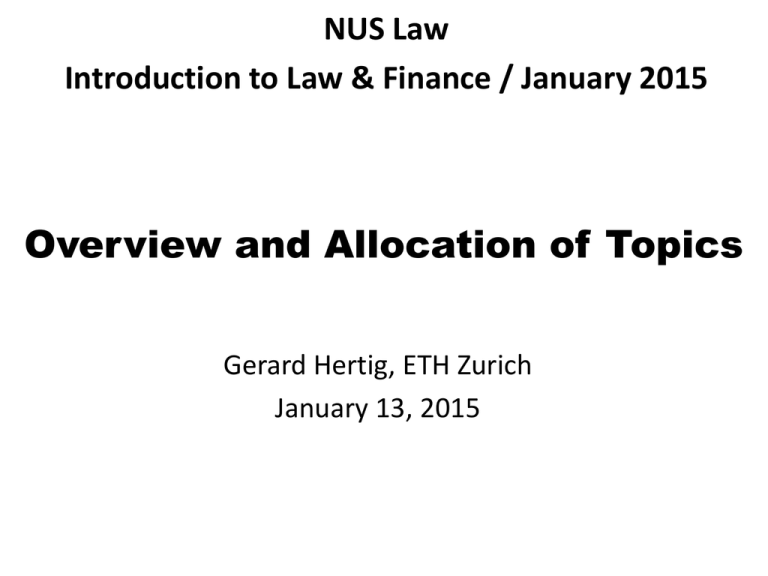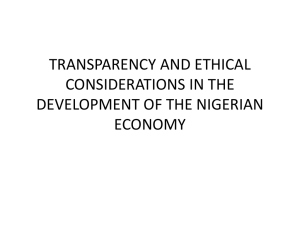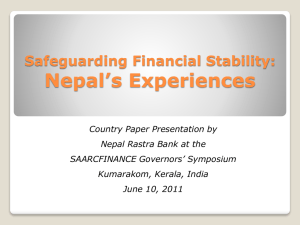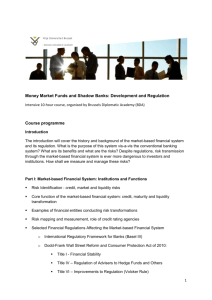ppt - Hertig
advertisement

NUS Law Introduction to Law & Finance / January 2015 Overview and Allocation of Topics Gerard Hertig, ETH Zurich January 13, 2015 Course Overview 1. Introduction: What is law & finance? 2. Financial systems and competition 3. Corporate governance 4. Prudential regulation and capital adequacy 5. Information and gatekeepers 6. Financial products and financial transactions 7. Resolution 13.01.2015 2 1. What is Law & Finance? 1. Moving from a dogmatic to a functional approach – Financial purpose / effect vs legal categories – Focus on transaction costs (coordination, drafting) and externalities vs focus on legal doctrines – Take better account of institutions 2. ‘Relying’ on empirical analysis – ‘Complete’ dataset vs leading cases/major transactions – Using proxies and constructing indexes 3. Integrating behavioral finance 13.01.2015 3 A. Implications for this Course • Take into account Economics and Politics • Adopt a broad view, policy-oriented approach • Deal with core regulatory issues • Based on a selection of 12 papers See A.1 – A.7 • Each session starts with a presentation based on a draft Comment on the relevant paper • Presentation is followed by comment by one participant followed by general discussion organized along core issues raised by the paper • Active individual participation is crucial 13.01.2015 4 A.1 Financial Systems and Competition • Perotti: Financial Systems – Political regimes and financial structures – Finance and the broadening of political participation – Political choices in democracy • Ratnovski: Competition Policy for Modern Banks – Banks are different in capital market based economy – Hard to regulating entry-exit as market structure plays limited role – Segmenting activities and reinforcing ‘nationalizations’ 13.01.2015 5 A.2 Comparative Corporate Governance • Morck/Yeung: Comparative Corporate Governance – Varieties of governance but standard model – Major differences arise at the occasion of crises – No clear trend towards convergence or divergence • Rock: Role of Institutional Investors – Significant increase in equity holdings – Apparently no corresponding increase in activism – Role of undiversified activists and passive investors 13.01.2015 6 A.3 Prudential Regulation and Capital • De la Torre/Ize: Macro-Prudential Regulation – Taking into account irrationality and externalities – Preventing private parties to take advantage of public interest interventions – Tempering mood swings • Flannery: Bank Capital – What is adequate capital? – Can banks ever have ‘enough’ capital? – What are the alternatives? 13.01.2015 7 A.4 Transparency and Information Providers • Enriques/Gilotta: Disclosure – Related party transactions as an instrument of tunelling – The need for sophisticated enforcement actors interventions – The role of medias • Becker/Opp: Replacing Ratings – The role of rating agencies – Are rating agencies too though or too lenient? – Using expected losses and book values instead 13.01.2015 8 A.5 Financial Products • Pistor: Law in Finance – Relation between law and finance: credibility vs flexibility – Application to sovereign debt, private credit markets and derivative markets – There is no equality in finance 13.01.2015 9 A.6 Executing Financial Transactions • Rehlon/Nixon: Central Counterparties – Counterparty vs. market risks – Managing the counterparty risk via margin calls – Supervising ‘systemic’ CCPs 13.01.2015 10 A.7 Resolution and Liquidation • Jackson/Skeel: Large Financial Institutions – Avoiding the resolution of large players – Bail-ins and mergers • Croci/Hertig/Nowak: Small Commercial Banks – Resolution is possible even in times of crisis – For some banks, bail-outs are more efficient than resolution 13.01.2015 11 B. Putting Law & Finance in Context 1. The evolving role of banks and capital markets 2. Institutions and finance 3. Law and Politics 4. Current role of law in finance 5. Implication for the approach adopted in this course 13.01.2015 12 B.1 Historical Perspective • Financial systems arise to better exploit gains from trade • First stage (3’000 BC – 1300 AD) – Mesopotamia Means of payment and loans – Greeks/Romans Money changers, deposit takers, mortgages – Fairs Recording of claims and liabilities • Second stage (1300 AD 1500 AD) – Northern Italy Bills of exchange, insurance, accounting • Third stage (1600 AD 1700 AD) – Amsterdam Stock exchange – Sweden Central Bank • Fourth stage (1700 AD ) – Stock market-oriented systems = Anglo-Saxon – Bank-oriented systems = Continental Europe 13.01.2015 13 Banks and Markets • Traditionally – UK & US considered market-oriented (why?) – Germany & France considered bank-oriented (why?) • Is this still true? – Globalization (convergence effect?) – Systemic risk (why does it matter?) • Was there ever a clear-cut distinction? – Many differences that matter (which ones?) – Similarities France/US, Germany/US 13.01.2015 14 Banks have a past Do they have a future? • Banks link between creditors and borrowers transformation function • Emergence during the Renaissance • From commercial to investment banking • Moving to asset/wealth management • What about P2P and its implications? 13.01.2015 15 B.2 Institutions and Finance Economic exchanges are shaped by institutions – Combination of formal and informal ‘rules of the game’ – Complement contracts in allocating risk and value among economic actors Quality of institutions explain economic growth Institutions that form financial ‘rules of the game’ Legal Political Cultural (including social capital, ethics and religion) 13.01.2015 16 Political Institutions • Unconstrained autocracy – Undermines financial accumulation – Political and economic elites – Limits entry and competition • Broadening political participation – Political power allocated to larger set of citizens – More savings, more credit • Democracy – Bank-based systems Civil law? – Market-based systems Common law? – Varieties of capitalism and State intervention Impact on competition Impact on the role of legal institutions 13.01.2015 17 Legal Institutions • Law-making – Statutes: ‘Private’, ‘public’ & ‘criminal’ law – Case law: Leading cases vs. other cases – Self-regulation: Clarification, barrier to entry and window dressing functions • Enforcement – Enforcement and compliance – Private enforcers, public officials, gatekeepers – Sanctions • Importance of politics and culture – Capture and molding effects – Time-invariance of culture 13.01.2015 18 B.3 Law & Politics: Market Integration • Single market models – US/Eurozone vs. UK/Switzerland – Impact on competition policy – Impact on free movement of financial services • Single passport and barriers to entry • Harmonization and mutual recognition • Optimal currency area – – – – Link between monetary and fiscal policy Impact on sovereign debt Supervising financial intermediaries Bailing out financial intermediaries (state aid and QE) 13.01.2015 19 Law & Politics: Statutory Framework • Reliability and stability – Good times: reliability of ex ante commitment – Bad times: Ex post adjustments • Temporarily overruling applicable law • Providing regulatory subsidies • State intervention: Public choice issues – – – – 13.01.2015 Industrial firms (listed and non-listed) Financial institutions (banks and asset managers) Controlling owners and SH activists Regulatory authorities 20 Law & Politics: Private Choice • Law to support contracting – Drafting costs : Customization ± optimal – Charter or individual contract Default (off-the-rack) – Possibility to improve, standardization function • Imperfect markets – More complex/significant than expected by many – can make contractual approach suboptimal – When is this the case and how should lawmakers impose mandates? 13.01.2015 21 B.4 Current Role of Law in Finance • Shift from relational to market-based finance • Law remains central to modern finance – At the core of financial instruments – Lending authority to public and private instruments – Delegating powers to public or private regulators • Financial markets are rule bound systems – Infrastructure – Contracts and liability 13.01.2015 22











